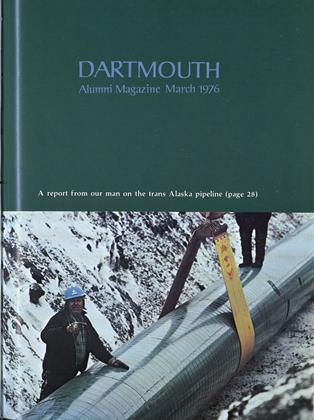America's railroads have been in decline since Dinah last blew her horn. They were the technological marvels of the 19th century but they're now insolvent, their service has slipped, their safety record has deteriorated, and their image is so bad it's as if Don Rickles had been handling their public relations.
But ASAPH H. HALL '55 believes the nation's railroads have reached a turning point. The new head of the Federal Railroad Administration (FRA), he believes the $6.4 billion rail bill President Ford signed early last month will reforge the nation's ribs of iron and steel. "There's no question that the government is fully committed to a more viable and healthy railroad system," he says.
Like BART general manager Frank Herringer '64, Hall entered the federal transportation program from private industry. He left his job as a marketing manager with Westinghouse in 1969 to become special assistant to the Under Secretary (and to the Deputy Under Secretary) of Transportation. In the spring of 1974 he was put in charge of the Northeast Corridor (Washington to Boston) rail passenger program and later became involved with freight transportation. The Senate confirmed his nomination as FRA administrator in August.
"It's a very exciting time for railroads," Hall says, explaining that the new rail bill gives FRA the tools to reverse the downward trend of the railroad industry. The bill provides interim financial assistance for railroads and administers a major dose of economic and regulatory reform, enabling freight trains to compete with large trucks and water carriers and allowing them greater rate flexibility. "The railroads have been completely regulated for a long time," Hall remarks. "As the interstate highway system was built and as inland waterway systems were improved, the railroads were put at a disadvantage."
Shepherding the 119-page bill through Congress in a form acceptable to the President and both houses is only one of Hall's recent projects. He's also responsible for enforcing rail safety regulations and for playing an advocacy role for railroads within the Department of Transportation.
Hall has given special attention to the Northeast Corridor since he joined the Department of Transportation. "Several studies have shown that the best way to handle the increase in demand for traffic over the next 20 years and to reduce congestion on highways and at airports is to increase rail service," Hall says. "It's better than putting in more lanes on the New Jersey Turnpike, or building another airport for New York City."
He believes AMTRAK can eventually turn a profit in the Northeast Corridor, the most densely populated belt in the United States, and he hopes trip times in the corridor will eventually be "at least comparable with the airlines, including the time required to get from the airport to town." Over the next five years $1.75 billion will be spent improving AMTRAK service. Top speeds in the corridor will reach 120 miles an hour. Some curves in the track will be straightened and rail electrification will be either installed or upgraded along the route. Much of the track will be completely rebuilt, with welded rail providing a safer and more comfortable ride.
Hall is confident that ConRail, the government-directed railroad corporation created by the new bill, will also be profitable. "The railroads have been underdogs since World War II," he says. "They've had little internally generated funds to keep the asset value of the property where it should be." The consolidation of seven bankrupt northeastern and midwestern railroads into ConRail and the $2.1 billion in loans and grants Congress appropriated for the system should make the freight carriers more competitive.
His background in the private sector is valuable in his new job, Hall is convinced. He doesn't consider himself "a railroader"; his job is "to get experts in the correct fields together at the right place at the right time." Working on the problems of the railroads has been "the most active and most interesting part" of his career. "Sometimes it's an overwhelming job... there's so much to do and now we have the tools to do it."
 View Full Issue
View Full Issue
More From This Issue
-
 Feature
FeatureGod and Man at Dartmouth
March 1976 By DAN NELSON -
 Feature
FeatureWhere Men Moil for Oil
March 1976 By KENT JOHNSON -
 Feature
FeatureA MEMORANDUM
March 1976 By McF. -
 Feature
FeatureOPTIONS & ALTERNATIVES
March 1976 By D.N. -
 Article
ArticlePeople & Places
March 1976 By JACK DEGANGE -
 Class Notes
Class Notes1974
March 1976 By STEPHEN D. SEVERSON, JACK E. THOMAS JR.
D.M.S.
-
 Article
ArticleWe're All Right, Jack
December 1975 By D.M.S. -
 Article
ArticleBasement Admiral
December 1975 By D.M.S. -
 Article
ArticleLife wifi Emma
March 1976 By D.M.S. -
 Article
ArticleRescuing an Elephant on Wheels
March 1976 By D.M.S. -
 Article
ArticleOf Placemats, Doors and Abraham Clark's Birthday
May 1976 By D.M.S. -
 Article
ArticleThe Seniors Writ Large: Some Sit Right, Some Don't
June 1976 By D.M.S.







